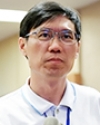研究成果 - 林志民 博士
化學動態學與光譜組

大氣化學與反應動態實驗室
主持人:林志民 博士
電子郵件:點此顯示(開新頁)
辦公室:335
辦公室電話:+886-2-2366-8258
實驗室:410, 411
實驗室電話:+886-2-2366-8248
主持人:林志民 博士
電子郵件:點此顯示(開新頁)
辦公室:335
辦公室電話:+886-2-2366-8258
實驗室:410, 411
實驗室電話:+886-2-2366-8248
Precise Measurements of Ozone-Destroying Molecule Calm Debate on How the Ozone Layer is Depleted by Human Activities
Science, 324, 781-784 (2009)
Institute of Atomic and Molecular Sciences (IAMS) have made precise measurements of chlorine peroxide (ClOOCl), calming recent international debate on exactly how humans are depleting the ozone layer. Their results were published in Science on May 8, 2009.
The chemical under debate, ClOOCl, is formed in the atmosphere due to human emissions of chlorofluorocarbons, major ingredients in refrigerants and propellants. In the presence of sunlight, photolysis of ClOOCl forms Cl atoms; Cl atoms react with ozone (O3) to form O2 and ClO, ClO can then dimerize to form ClOOCl again, thus catalytically converting O3 to O2. The larger the absorption cross section of ClOOCl, the faster it absorbs sunlight, then the faster the chlorine atoms are generated, and thus the faster the ozone is destroyed.
Dr. Jim J. Lin and his colleagues at IAMS designed an elegant experiment using a chlorine peroxide molecular beam, and determined the photodissociation probability (the probability of the chlorine peroxide being split into chlorine atoms and oxygen by light) by measuring the decrease in beam intensity after laser irradiation. By precisely measuring the ratio of the molecules before and after laser irradiation, they were able to quantify the absorption cross section without knowing the absolute concentration. Using currently accepted kinetic models, their new results can well explain the ozone-hole formation as well as the partition of ClO/ClOOCl from field measurements, indicating that the current atmospheric models are in fact still valid.
The chemical under debate, ClOOCl, is formed in the atmosphere due to human emissions of chlorofluorocarbons, major ingredients in refrigerants and propellants. In the presence of sunlight, photolysis of ClOOCl forms Cl atoms; Cl atoms react with ozone (O3) to form O2 and ClO, ClO can then dimerize to form ClOOCl again, thus catalytically converting O3 to O2. The larger the absorption cross section of ClOOCl, the faster it absorbs sunlight, then the faster the chlorine atoms are generated, and thus the faster the ozone is destroyed.
Dr. Jim J. Lin and his colleagues at IAMS designed an elegant experiment using a chlorine peroxide molecular beam, and determined the photodissociation probability (the probability of the chlorine peroxide being split into chlorine atoms and oxygen by light) by measuring the decrease in beam intensity after laser irradiation. By precisely measuring the ratio of the molecules before and after laser irradiation, they were able to quantify the absorption cross section without knowing the absolute concentration. Using currently accepted kinetic models, their new results can well explain the ozone-hole formation as well as the partition of ClO/ClOOCl from field measurements, indicating that the current atmospheric models are in fact still valid.
目前位置:本所人員 / 研究人員 / 林志民 / 研究成果
中央研究院 原子與分子科學研究所版權所有 |
個人隱私權聲明 |
保有個資檔案公開項目彙整表 |
行動版
地址: 106319 台北市羅斯福路四段一號 或 106923 臺北臺大郵局 第23-166號信箱
電話:886-2-2362-0212 傳真:886-2-2362-0200 電子郵件:iamspublic@gate.sinica.edu.tw
最後更新於 2024-04-19 09:18:44
地址: 106319 台北市羅斯福路四段一號 或 106923 臺北臺大郵局 第23-166號信箱
電話:886-2-2362-0212 傳真:886-2-2362-0200 電子郵件:iamspublic@gate.sinica.edu.tw
最後更新於 2024-04-19 09:18:44
 中央研究院 原子與分子科學研究所
中央研究院 原子與分子科學研究所
